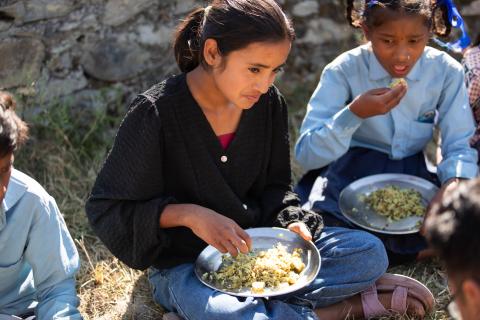School-age children and adolescent nutrition status in South Asia: A scoping review
This is a summary of the following paper: Choedon T, Brennan E, Joe W et al (2023) Nutritional status of school-age children 5-19 years in South Asia: A scoping review. Maternal and Child Nutrition, e13607. https://doi.org/10.1111/mcn.13607
Limited data on malnutrition in South Asian school-age children hampers effective nutrition policies, programmes, and research. A scoping review of 295 studies (January 2016 to November 2022) synthesises evidence on undernutrition, overweight/obesity, and micronutrient deficiencies. Of these, 54% were from India, 12% from Pakistan, 12% from Bangladesh, 11% from Nepal, and 7% from Sri Lanka.
The evidence highlights a triple burden of malnutrition among South Asian children and adolescents with widespread but varied rates. This underscores the need for targeted policies in the region. Identified interventions like education, fortification, supplementation, and school feeding programmes show potential, but more research is needed for effective strategies that address the rising burden of overnutrition. Greater standardisation of anthropometric indicators and more regular monitoring is needed, with further research required to inform the scalability and sustainability of small-scale interventions.
The study's strengths include a comprehensive literature search. Limitations include the absence of qualitative analysis and potential data gaps (especially in Bhutan, the Maldives, and Afghanistan). A lack of micronutrient deficiency data, irregular national nutrition surveys, and insufficient large-scale intervention studies was present.
Stunting
Prevalence varied from 3.7% (Sri Lanka) to 71.7% (Pakistan) across 64 studies. Factors influencing stunting included household wealth, social affiliations, maternal education, adolescent nutrition awareness, paternal occupation, rural residence, safe drinking water access, and physical inactivity. Overall, 4 stunting interventions were identified, with 3 Indian studies showing mixed impacts and a Nepali school garden programme showing no impact on stunting but positively influencing nutrition knowledge and practices.
Wasting
Prevalence ranged from 3.0% to 48.0% across Bangladesh, India, Pakistan, and Sri Lanka across 9 studies. Sex differences in wasting prevalence were noted, with a higher prevalence among girls in 6 studies.
Underweight and thinness
Across all studies, the prevalence of thinness ranged from 1.9% (Pakistan) to 88.8% (India), while the prevalence of underweight ranged from 9.5% (Bangladesh) to 84.4% (India). However, studies used different cut-offs and indicators, making comparing contexts difficult. Family size, household income, parents’ education, socioeconomic factors, low dietary diversity, water sanitation and hygiene practices, physical inactivity, and a history of illness were reported as predictors of thinness. Interventions in India and Nepal, including a school meals programme and multi-component interventions, showed mixed impacts on thinness.
Overweight and obesity
Among South Asian girls aged 15–19, overweight prevalence ranged from 2.9% (Nepal) to 21.0% (Pakistan), with obesity from 0.4% (Nepal) to 5.2% (Sri Lanka). Rural areas generally show lower rates and girls were more likely to have a higher body mass index. Socioeconomic factors, dietary habits, and physical activity influence prevalence. School-based interventions in India had varied impacts.
Micronutrient deficiencies
Prevalence varies for anaemia (31.3%–60.0%), iron deficiency (7.1%–30.0%), iodine deficiency (6.3%–31.8%) and vitamin D deficiency (8.4%–93.0%). Overall, 18 interventions targeted micronutrient deficiencies, with positive impacts reported in some studies.
Dietary patterns and quality
Low dietary diversity, cereal-based diets, and inadequate fruit and vegetable consumption are prevalent. Socioeconomic status influences diet quality. Fast food and soft drink consumption was common, and adolescent hunger was reported in 4 studies. An intervention in Nepal showed positive changes in dietary habits.


